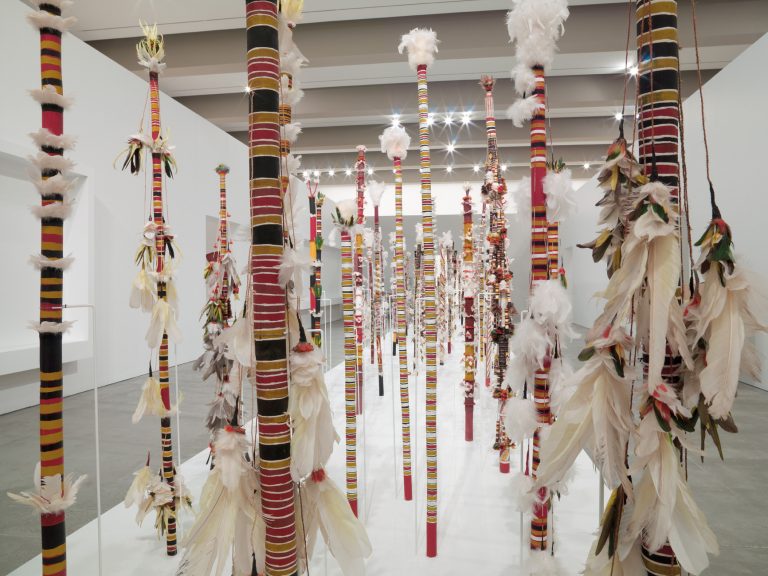We acknowledge the Traditional Owners of the land on which the Queensland Art Gallery | Gallery of Modern Art stands and recognise the creative contribution First Australians make to the art and culture of this country.

Frank DJEKULA (Gupapuyngu people NT) | Richard GALNGADIWUY | Henry Gambika NUPURRA (Djambarrpuyngu people NT) | Richard Gandhuwuy GARRAWURRA (Liyagawumirr people NT) | David Lakarriny GURRUWIWI | Gali Yalkarriwuy GURRUWIWI | Henry Dhalnganda GURRUWIWI | Paul GURRUWIWI | Richard Dhaymutha GURRUWIWI | Trevor GURRUWIWI (Galpu people NT) | Wilson LANYDJURRA (Gunbirrtja Malarra people NT) | Ian WURUWUL (Ganalpuyngu people NT) | Terry Dhurritjini YUMBULUL (Warramirri people NT) | Banumbirr (Morning Star poles) (installation view) | Wood, bark fibre string, cotton thread, feathers, commercial feathers, human hair, native beeswax, natural pigments, synthetic polymer paint | Collection: Queensland Art Gallery | © The artists. Licensed by Viscopy, Sydney
Artists of Galiwin’ku (Elcho Island), Northern TerritoryBanumbirr (Morning star poles) unknown date
Not Currently on Display
These banumbirr (morning star poles) celebrate the importance of the morning star and resemble those used in ceremonies in north-eastern Arnhem Land in the Northern Territory. It is often told that banumbirr rose in the east, lighting the way for the creator ancestors on their journey to the mainland from Burralku, the island where the souls of the deceased reside.
Every day at sunset, the spirits on Burralku hold a morning star ceremony. As the dancing intensifies, disturbing the dust, it creates the twilight which gradually merges into darkness. During the day and into night, the star is hidden by an old woman who holds it in a special bag. Each day, just before dawn, the old woman releases the star on a long string.
First, it ascends to the top of a tall pandanus tree to survey the places it has to visit, then it flies over Arnhem Land heralding the dawn. As the sun appears, the old woman reels banumbirr in by its feathered string to be hidden again until the next evening; the elusive star disappears as the morning light intensifies.
The banumbirr (morning star poles) in this grouping were made by artists from Galiwin’ku (Elcho Island), a small island off the northern shore of Arnhem Land. Both men and women are responsible for making different parts of the poles, while clan leaders oversee their development and take responsibility for passing on banumbirr knowledge and rituals.
The strings attached to the poles represent the fine roots on yam plants, while the beautiful tufts of feathers (pul-pul) on the tips of some poles represent the bright morning star.